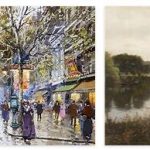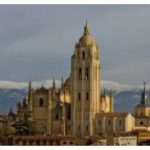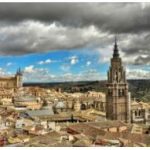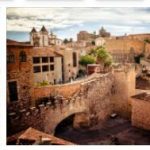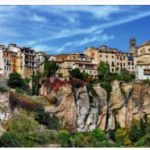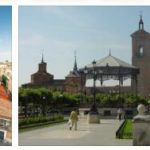Architecture
The influence of the Byzantine culture caused an upswing in urban planning. The type of cross-domed church was adopted by Byzantium, after which Byzantine masters built the first churches in the Kievan Rus, such as the Savior Cathedral in Chernigov (1036), the Sophia cathedrals in Kiev (1037 to around 1100), in Polotsk (1044-66) and that in Novgorod (1045–52), which simplified the Kiev model with five naves and domes and brought it to a closed effect, the Assumption Cathedral in the Kiev Pechersk Lavra (1073–78; destroyed 1941). Later Russian builders relaxed the Byzantine rigor of sacred architecture based on local traditions of timber construction.
Monumental buildings in the Kiev Empire were almost entirely made of stone, and, as the palaces excavated in Kiev show, they had spacious vaults and rich interiors (marble and slate cornices, mosaics, frescoes). The large Novgorod buildings from the 12th century were based on the ground plan v. a. at the Kiev Cathedral of the Assumption, so the churches in Jurjewkloster (1119–30) and Antoniuskloster (1117–19). The west building of both monastery churches is provided with domes and a stair tower; their external structure shows echoes of Romanesque architecture.
When the Kiev empire fell apart at the beginning of the 13th century, there was an increasing regionalization in Old Russian art. From the middle of the 12th to the middle of the 13th century in the Principality of Vladimir-Suzdal, architecture developed with a view to decorative effects and more open to western, particularly Lombard, influences. The secular and sacred buildings, mostly made of plastered brick masonry with the help of foreign builders, are characterized by the harmony of proportions and plastic structure of the outer walls: palace buildings (1158-65, only preserved in fragments) and Mariä-Schutz (Pokrow) Church on the Nerl (1165) in Bogoljubowo, the Demetriuskirche (1194–97) in the Kremlin of Vladimir, the St. George’s Cathedral (1230–34) in Jurjew-Polski.
The Archangel Michael Church (1191–94) with its three-dimensional structure (with three separate vestibules) is particularly characteristic of the church building in Smolensk. In Novgorod, an independent church building developed in the second half of the 14th century. The cubic structure, predominantly of the four-pillar type, was covered by two intersecting gable roofs, the outer walls closed at the top with cloverleaf arches and were decorated with notch-like ornaments and symbols, among others. the Fyodor Stratilat Church (1360/61) and the Cathedral of the Transfiguration of Christ on Ilya Street (1374).
The early churches of the Moscow Empire followed the principle of dynamic building design. Support structures made of step-like ascending belt arches, which led from the outer walls to the central dome, replaced the pillars (e.g. Cathedral of the Savior in Moscow’s Andronikov Monastery, 1420–27). As Grand Duke Ivan III. In the second half of the 15th century began to expand the Moscow Kremlin, he brought in Italian builders, so among others. A. Fieravanti, P.A. Solari, A.F. Nowy, M. Ruffo which in addition to the Assumption of Mary Uspenski (1475–79), the Archangel Michael (1505–08) and the Annunciation Cathedral (1484–89), all following the Russian model, also built fortification facilities and secular buildings, among others. the Facet Palace (Granowitaja Palata, 1487–91).
The fortifications of the Moscow Kremlin (1485 ff.) Influenced the other Kremlin complexes in Russia (including Novgorod, 1484–90; Kolomna, 1525–31; Smolensk, 1595–1602) and the fortifications of many monasteries (including New Virgins [Novodewitschi] – Monastery in Moscow, around 1600, Spasso-Jefimi Monastery in Suzdal, around 1670–80). The surge in innovation brought about by the Italians allowed Russian masters to imitate forms of wood construction in stone, as apparently happened with the Assumption Cathedral of Kolomenskoye (1532) (type of “tent roof church”). The St. Basil’s Cathedral (1555–60) on the Red Square in Moscow, with its nine tower churches, the gallery and the bell tower, is also likely to have copied a wooden structure.
In the late phase of old Russian architecture in the 17th century, the urge to climb higher, for more colors and décor as well as a rich, often asymmetrical structure of the building dominated. The towers of the Moscow Kremlin were built in the shape of a tent roof. Towering gate churches were built above the monastery gates (New Virgins Monastery in Moscow, Troize-Sergijewa-Lavra in Sergiev Posad). At the end of the 17th century, the Moscow “imperial style” took on clear features of the European baroque and developed into the harmoniously structured, representative Naryshkin baroque, for example the church of the Virgin Mary (Pokrov), which is bulging out below and surrounded by extensive galleries and open stairs Fili (1690-93).
Plastic
The relief was important until the 17th century. Early relief panels from Kiev (11th century) are close to Byzantine art; a. Lombard, the relief cycles of the Church of Demetrius in the Kremlin by Vladimir Romanesque and Armenian-Georgian influence. The works of W. D. Jermolin (Sankt-Georgs-Gruppe, around 1462–64; Moscow, Tretyakov Gallery) brought a first high point in the 15th century. The figural round sculpture remained popular and only reached a higher level at the end of the 17th century.
Painting
Mosaics and wall paintings of the first churches in Kiev (10th / 11th centuries) were made by Byzantine masters. While the frescoes (around 1109) in the St. Sophia Cathedral in Novgorod were in the Byzantine / Kiev tradition, the wall painting in the Church of the Nativity of the Virgin in Novgorod’s Monastery of St. Anthony was influenced by the Western Romanesque. Illumination was limited to copies of Bulgarian illuminated manuscripts (Ostromir Gospels, 1057, Saint Petersburg, Saltykov Shchedrin Library). In the 14th century the center of illumination had shifted from Kiev via Novgorod to Moscow. Icons of the 12th / 13th centuries Century show a uniform, byzantine style and cannot be clearly assigned to centers (Kiev, Vladimir-Suzdal, Yaroslavl, Novgorod). The wall and icon painting Novgorod received by Theophanes gave the Greeks new impetus in the late 14th century. His expressive style then spread to Moscow, where he and A. Rublev played a leading role in the iconostasis (1405) of the Annunciation Cathedral in the Moscow Kremlin.
The subjects of the Novgorod icons were enriched by scenic and historical depictions, and a preference for animal motifs can also be recognized. The icons from Pskov, carried by a strong feeling for nature, represented their own style with their emphatically red-green coloring. Around 1500 were Dionissi and his sons in painting, which in the 16th century became more multi-figured and more subtle in the field of icons. Since the middle of the 17th century, wall and icon painting took on slightly baroque features. In other words, the figures were made more vivid, set in ideal landscapes, and the themes taken from the New Testament such as the Passion, parables, Acts of the Apostles and the Apocalypse were given a slightly sentimental design. Portrait-like icons, which tend to be portrayed, also emerged more frequently. A typical representative of this style of painting was the court painter S. F. Uschakow. Russian masters also tried their hand at woodcut, less often with copperplate engraving.

